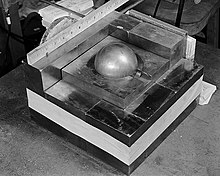Demon Core
Demon Core (dt. " Demon core") is the nickname of a 89 mm, 6.2 kg of plutonium core as that in two accidents in the Los Alamos National Laboratory a supercritical state reached. In both accidents, the triggering scientists died of the consequences.
First incident on August 21, 1945
The physicist Harry K. Daghlian Jr. worked alone on an experiment on the effect of tungsten carbide as a neutron reflector . He stacked tungsten carbide bars around the plutonium core. When he was about to put another bar on the stack, a scintillation counter showed him that the neutron radiation had increased. Realizing that the next ingot would make the mass overly critical, he withdrew his hand. The bar fell down onto the core and released ionizing radiation. He immediately removed the bar but was still exposed to a lethal dose of radiation. Daghlian died 25 days later, on September 15, 1945.
Second incident on May 21, 1946
The Canadian physicist Louis Slotin and seven of his colleagues were working on an experiment in which the initial phase of a chain reaction should be initiated. To do this, they arranged two beryllium hemispheres as neutron reflectors around the plutonium core. The decisive factor was that the beryllium hemispheres were not allowed to form a complete sphere around the plutonium core.
Slotin had already carried out similar experiments and was aware of the danger. The experimental set-up was also called tickling the dragon's tail (" tickling the dragon's tail "). Normally, the safety distance between the two beryllium halves was ensured by a mechanism on rails, which slowly pushed the beryllium hemispheres towards the plutonium and thus increased reactivity. A spacer prevented the two hemispheres from touching.
The experiment was changed on the day of the accident: Slotin held one beryllium hemisphere in his hand and slowly brought it up to the plutonium. Instead of the spacer, he uses a screwdriver to prevent the two beryllium hemispheres from touching. The screwdriver slipped out, the plutonium core was completely surrounded by beryllium, and a chain reaction was triggered that led to the release of a high dose of radiation. Slotin wanted to interrupt the reaction by pulling away a hemisphere to prevent the others present from receiving lethal doses . However, the supercritical state ended by itself due to thermal expansion. Slotin died nine days later of acute radiation sickness . His assistant, who was standing next to him, suffered serious injuries and permanent damage. Some sources suspect that three other scientists also died years later as a result of the accident.
Later use of the plutonium core
The Demon Core was originally intended to be used in the nuclear weapons tests of Operation Crossroads . After the criticality accidents, however, more time was required for the radioactivity of the core to subside. As a result, the use for the 3rd part of the test series, provisionally called Charlie, was planned. However, this was canceled due to the unexpectedly high radiation exposure after the underwater test Baker and the impossibility of decontamination of the test warships. The core was later melted down and the material reused for another core.
Movies and TV series
The accidents were summarized in the film Fat Man and Little Boy (German title: Die Schattenmacher ) from 1989.
In the Stargate SG-1 series , the second accident was processed in a modified form in episode 21 of season 5 .
See also
Individual evidence
- ^ Trinity Atomic website. ( Memento of the original from February 27, 2014 in the Internet Archive ) Info: The archive link was inserted automatically and has not yet been checked. Please check the original and archive link according to the instructions and then remove this notice.
- ^ The Demon Core. November 24, 2008
- ↑ Alex Wellerstein: The Demon Core and the Strange Death of Louis Slotin . In: The New Yorker , May 21, 2016. Retrieved May 22, 2016.
- ↑ Alex Wellerstein: The blue flash . Restricted data. May 23, 2016. Retrieved May 23, 2016.
Web links
- McLaughlin, et al. A Review of Criticality Accidents. (Report LA-13638; PDF; 3.9 MB), May 2000.

